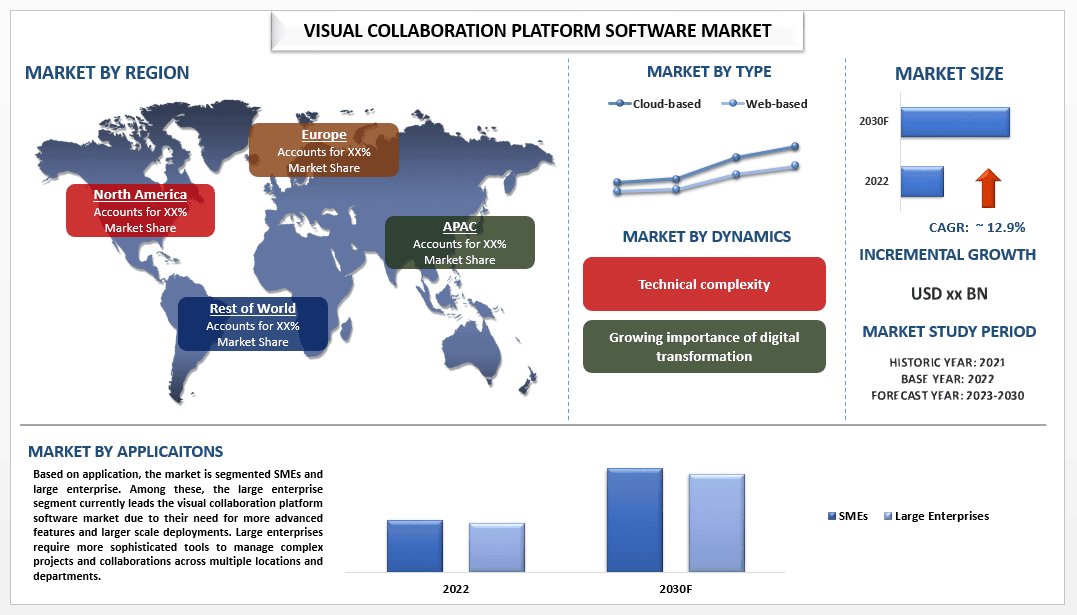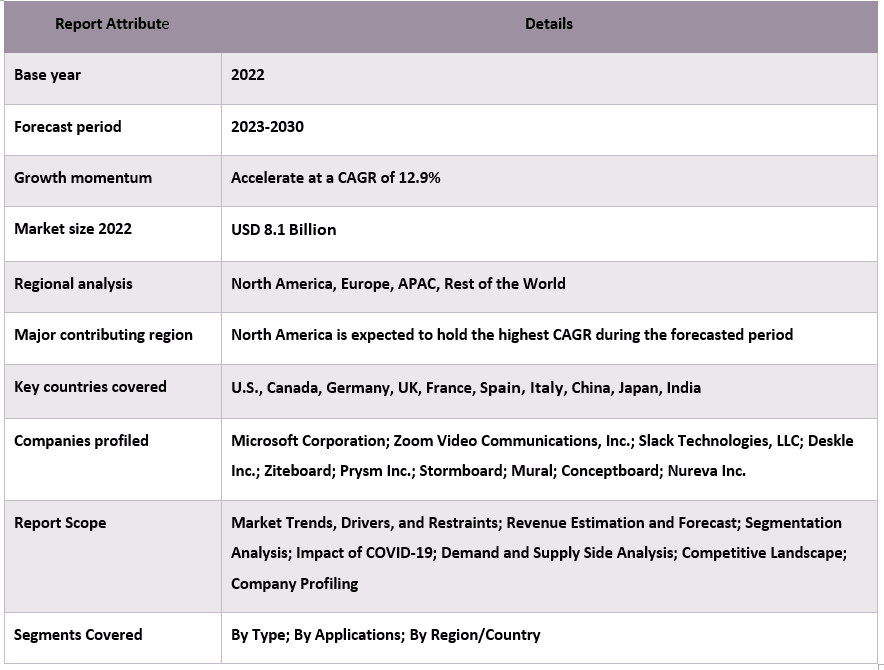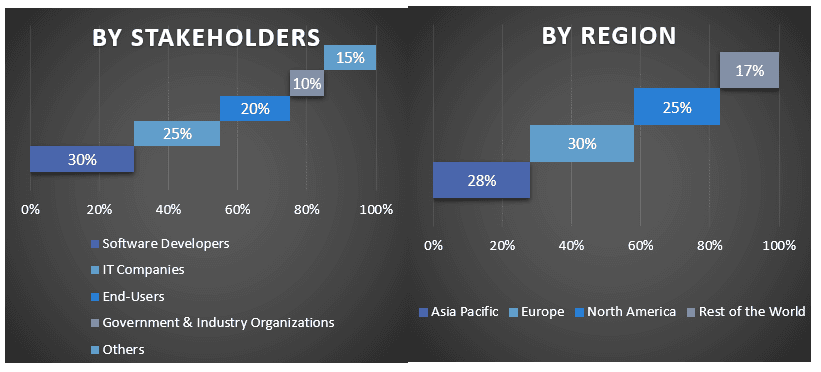- Trang chủ
- Về chúng tôi
- Ngành
- Dịch vụ
- Đọc
- Liên hệ với chúng tôi
Thị trường Phần mềm Nền tảng Cộng tác Trực quan: Phân tích Hiện tại và Dự báo (2023-2030)
Nhấn mạnh vào Loại hình (Trên nền tảng đám mây và Trên nền tảng web); Ứng dụng (DNVVN và Doanh nghiệp lớn) và Khu vực/Quốc gia

Thị trường Phần mềm Nền tảng Cộng tác Trực quan được định giá 8,1 tỷ đô la vào năm 2022 và dự kiến sẽ tăng trưởng với tốc độ ổn định khoảng 12,9% trong giai đoạn dự báo (2023-2030). Ngoài ra, những tiến bộ trong công nghệ đã dẫn đến sự phát triển của phần mềm nền tảng cộng tác trực quan tinh vi và giàu tính năng hơn, điều này đã thúc đẩy hơn nữa sự tăng trưởng của thị trường này. Ví dụ: một số nền tảng hiện cung cấp các tính năng nâng cao như thực tế tăng cường (AR) và thực tế hỗn hợp (MR), cho phép các nhóm cộng tác trong môi trường nhập vai.
Một số công ty lớn hoạt động trên thị trường bao gồm Microsoft Corporation; Zoom Video Communications, Inc.; Slack Technologies, LLC; Deskle Inc.; Ziteboard; Prysm Inc.; Stormboard; Mural; Conceptboard; Nureva Inc.
Thông tin chi tiết được trình bày trong Báo cáo
“Trong số các loại, phân khúc dựa trên đám mây hiện là phân khúc hàng đầu của thị trường trong giai đoạn dự báo.”
Dựa trên loại hình, thị trường được chia thành dựa trên đám mây và dựa trên web. Trong số đó, phân khúc dựa trên đám mây đang dẫn đầu thị trường phần mềm nền tảng cộng tác trực quan do tính dễ sử dụng, khả năng mở rộng và hiệu quả chi phí. Các giải pháp dựa trên đám mây cho phép người dùng truy cập phần mềm từ mọi nơi và trên mọi thiết bị, khiến nó trở nên lý tưởng cho các nhóm làm việc từ xa. Ngoài ra, các giải pháp dựa trên đám mây thường được cập nhật tự động, đảm bảo rằng người dùng luôn có quyền truy cập vào các tính năng và bản vá bảo mật mới nhất. Hơn nữa, nhiều giải pháp dựa trên đám mây cung cấp mô hình định giá trả tiền theo mức sử dụng, có thể thân thiện với ngân sách hơn so với các giải pháp tại chỗ truyền thống. Khi ngày càng có nhiều công ty chuyển sang các giải pháp dựa trên đám mây, nhu cầu về phần mềm nền tảng cộng tác trực quan dựa trên đám mây dự kiến sẽ tiếp tục tăng. Ngoài ra, IDC dự đoán rằng đến năm 2023, hơn một nửa tổng chi tiêu CNTT trong khu vực sẽ dành cho các dịch vụ dựa trên đám mây.
Phạm vi Báo cáo Thị trường Phần mềm Nền tảng Cộng tác Trực quan

“Bắc Mỹ sẽ nắm giữ một thị phần đáng kể trên thị trường.”
Bắc Mỹ đã trải qua sự tăng trưởng vượt bậc trong những năm gần đây, được thúc đẩy bởi sự phát triển nhanh chóng của các hoạt động làm việc từ xa và nhu cầu ngày càng tăng về giao tiếp ảo liền mạch. Khi các doanh nghiệp thích ứng với bối cảnh kỹ thuật số, đã có sự gia tăng đáng kể trong việc áp dụng các công cụ như Zoom, Microsoft Teams và Cisco Webex, tạo điều kiện cho hội nghị truyền hình, bảng trắng ảo và chia sẻ tài liệu cộng tác. Đại dịch COVID-19 đã đẩy nhanh đáng kể xu hướng này, buộc các tổ chức phải áp dụng các công cụ cộng tác từ xa để duy trì tính liên tục trong kinh doanh. Thị trường đã trở nên năng động, với những đổi mới và cải tiến liên tục về tính năng, bảo mật và khả năng tích hợp. Nhu cầu về các giải pháp linh hoạt và thân thiện với người dùng giúp tăng cường khả năng làm việc nhóm trên các nhóm phân tán về mặt địa lý là một yếu tố chính thúc đẩy sự tăng trưởng của thị trường giải pháp nền tảng cộng tác trực quan ở Bắc Mỹ.
Lý do nên mua báo cáo này:
- Nghiên cứu bao gồm phân tích quy mô và dự báo thị trường được xác thực bởi các chuyên gia ngành quan trọng đã được xác thực.
- Báo cáo trình bày đánh giá nhanh về hiệu suất tổng thể của ngành trong nháy mắt.
- Báo cáo bao gồm phân tích chuyên sâu về các đồng nghiệp nổi bật trong ngành với trọng tâm chính vào tình hình tài chính kinh doanh chính, danh mục sản phẩm, chiến lược mở rộng và các phát triển gần đây.
- Kiểm tra chi tiết các động lực, hạn chế, xu hướng chính và cơ hội thịnh hành trong ngành.
- Nghiên cứu bao gồm toàn diện thị trường trên các phân khúc khác nhau.
- Phân tích chuyên sâu về ngành ở cấp khu vực.
Tùy chọn tùy chỉnh:
Thị trường Phần mềm Nền tảng Cộng tác Trực quan toàn cầu có thể được tùy chỉnh thêm theo yêu cầu hoặc bất kỳ phân khúc thị trường nào khác. Bên cạnh đó, UMI hiểu rằng bạn có thể có nhu cầu kinh doanh riêng, vì vậy vui lòng liên hệ với chúng tôi để nhận báo cáo hoàn toàn phù hợp với yêu cầu của bạn.
Mục lục
Phương Pháp Nghiên Cứu cho Phân Tích Thị Trường Phần Mềm Nền Tảng Cộng Tác Trực Quan (2023-2030)
Phân tích thị trường lịch sử, ước tính thị trường hiện tại và dự báo thị trường tương lai của Thị trường Phần mềm Nền tảng Cộng tác Trực quan toàn cầu là ba bước chính được thực hiện để tạo và phân tích việc áp dụng các giải pháp nền tảng cộng tác trực quan ở các khu vực chính trên toàn cầu. Nghiên cứu thứ cấp toàn diện đã được thực hiện để thu thập các số liệu thị trường lịch sử và ước tính quy mô thị trường hiện tại. Thứ hai, để xác thực những thông tin chi tiết này, nhiều phát hiện và giả định đã được xem xét. Hơn nữa, các cuộc phỏng vấn sơ cấp toàn diện cũng đã được thực hiện với các chuyên gia trong ngành trên toàn bộ chuỗi giá trị của Thị trường Phần mềm Nền tảng Cộng tác Trực quan toàn cầu. Sau khi giả định và xác thực các số liệu thị trường thông qua các cuộc phỏng vấn sơ cấp, chúng tôi đã sử dụng phương pháp tiếp cận từ trên xuống/từ dưới lên để dự báo quy mô thị trường hoàn chỉnh. Sau đó, các phương pháp phân tích thị trường và tam giác dữ liệu đã được áp dụng để ước tính và phân tích quy mô thị trường của các phân khúc và phân khúc con liên quan đến ngành. Phương pháp luận chi tiết được giải thích dưới đây:
Phân Tích Quy Mô Thị Trường Lịch Sử
Bước 1: Nghiên Cứu Chuyên Sâu về Nguồn Thứ Cấp:
Nghiên cứu thứ cấp chi tiết đã được tiến hành để thu thập quy mô thị trường lịch sử của Thị trường Phần mềm Nền tảng Cộng tác Trực quan thông qua các nguồn nội bộ của công ty như báo cáo thường niên & báo cáo tài chính, các bài thuyết trình hiệu suất, thông cáo báo chí, v.v., và các nguồn bên ngoài bao gồm tạp chí, tin tức & bài viết, ấn phẩm của chính phủ, ấn phẩm của đối thủ cạnh tranh, báo cáo ngành, cơ sở dữ liệu của bên thứ ba và các ấn phẩm đáng tin cậy khác.
Bước 2: Phân Khúc Thị Trường:
Sau khi có được quy mô thị trường lịch sử của Thị trường Phần mềm Nền tảng Cộng tác Trực quan, chúng tôi đã tiến hành phân tích thứ cấp chi tiết để thu thập thông tin chi tiết và chia sẻ thị trường lịch sử cho các phân khúc & phân khúc con khác nhau cho các khu vực chính. Các phân khúc chính được bao gồm trong báo cáo như loại và ứng dụng. Phân tích cấp quốc gia sâu hơn đã được tiến hành để đánh giá việc áp dụng tổng thể các mô hình kiểm tra ở khu vực đó.
Bước 3: Phân Tích Yếu Tố:
Sau khi thu thập được quy mô thị trường lịch sử của các phân khúc và phân khúc con khác nhau, chúng tôi đã tiến hành phân tích yếu tố chi tiết để ước tính quy mô thị trường hiện tại của Thị trường Phần mềm Nền tảng Cộng tác Trực quan. Hơn nữa, chúng tôi đã tiến hành phân tích yếu tố sử dụng các biến phụ thuộc và độc lập như các loại và ứng dụng khác nhau của các giải pháp nền tảng cộng tác trực quan. Một phân tích kỹ lưỡng đã được thực hiện về các kịch bản cung và cầu có tính đến các quan hệ đối tác hàng đầu, sáp nhập và mua lại, mở rộng kinh doanh và ra mắt sản phẩm trong lĩnh vực Thị trường Phần mềm Nền tảng Cộng tác Trực quan trên toàn cầu.
Ước Tính & Dự Báo Quy Mô Thị Trường Hiện Tại
Định Cỡ Thị Trường Hiện Tại: Dựa trên những hiểu biết sâu sắc có thể hành động được từ 3 bước trên, chúng tôi đã đạt được quy mô thị trường hiện tại, những người chơi chính trong Thị trường Phần mềm Nền tảng Cộng tác Trực quan toàn cầu và thị phần của các phân khúc. Tất cả các tỷ lệ phần trăm yêu cầu, chia nhỏ và phân tích thị trường đã được xác định bằng cách sử dụng phương pháp thứ cấp đã đề cập ở trên và được xác minh thông qua các cuộc phỏng vấn sơ cấp.
Ước Tính & Dự Báo: Đối với ước tính và dự báo thị trường, trọng số đã được gán cho các yếu tố khác nhau bao gồm động lực & xu hướng, hạn chế và cơ hội có sẵn cho các bên liên quan. Sau khi phân tích các yếu tố này, các kỹ thuật dự báo có liên quan, tức là phương pháp tiếp cận từ trên xuống/từ dưới lên, đã được áp dụng để đưa ra dự báo thị trường cho năm 2030 cho các phân khúc và phân khúc con khác nhau trên các thị trường lớn trên toàn cầu. Phương pháp nghiên cứu được áp dụng để ước tính quy mô thị trường bao gồm:
- Quy mô thị trường của ngành, về doanh thu (USD) và tỷ lệ chấp nhận của Thị trường Phần mềm Nền tảng Cộng tác Trực quan trên các thị trường lớn trong nước
- Tất cả các tỷ lệ phần trăm, chia nhỏ và phân tích các phân khúc và phân khúc con của thị trường
- Những người chơi chính trong Thị trường Phần mềm Nền tảng Cộng tác Trực quan toàn cầu về các sản phẩm được cung cấp. Ngoài ra, các chiến lược tăng trưởng được những người chơi này áp dụng để cạnh tranh trong thị trường đang phát triển nhanh chóng.
Xác Thực Quy Mô và Thị Phần
Nghiên Cứu Sơ Cấp: Các cuộc phỏng vấn chuyên sâu đã được thực hiện với những Người có Ý kiến Chủ chốt (KOL), bao gồm các Giám đốc Điều hành Cấp cao (CXO/VP, Trưởng phòng Kinh doanh, Trưởng phòng Tiếp thị, Trưởng phòng Vận hành, Trưởng phòng Khu vực, Trưởng phòng Quốc gia, v.v.) trên khắp các khu vực chính. Các phát hiện nghiên cứu sơ cấp sau đó đã được tóm tắt và phân tích thống kê đã được thực hiện để chứng minh giả thuyết đã nêu. Các thông tin đầu vào từ nghiên cứu sơ cấp đã được hợp nhất với các phát hiện thứ cấp, do đó biến thông tin thành những hiểu biết sâu sắc có thể hành động.
Phân Chia Người Tham Gia Sơ Cấp ở Các Khu Vực Khác Nhau

Kỹ Thuật Thị Trường
Kỹ thuật tam giác dữ liệu đã được sử dụng để hoàn thành ước tính thị trường tổng thể và đưa ra các con số thống kê chính xác cho từng phân khúc và phân khúc con của Thị trường Phần mềm Nền tảng Cộng tác Trực quan toàn cầu. Dữ liệu được chia thành nhiều phân khúc & phân khúc con sau khi nghiên cứu các thông số và xu hướng khác nhau trong các lĩnh vực loại và ứng dụng trong Thị trường Phần mềm Nền tảng Cộng tác Trực quan toàn cầu.
Mục Tiêu Chính của Nghiên Cứu Thị Trường Phần Mềm Nền Tảng Cộng Tác Trực Quan Toàn Cầu
Các xu hướng thị trường hiện tại & tương lai của Thị trường Phần mềm Nền tảng Cộng tác Trực quan toàn cầu đã được xác định trong nghiên cứu. Các nhà đầu tư có thể thu được những hiểu biết sâu sắc về chiến lược để làm cơ sở cho quyết định đầu tư của họ dựa trên phân tích định tính và định lượng được thực hiện trong nghiên cứu. Các xu hướng thị trường hiện tại và tương lai xác định sức hấp dẫn tổng thể của thị trường ở cấp khu vực, cung cấp một nền tảng cho người tham gia công nghiệp khai thác thị trường chưa được khai thác để hưởng lợi từ lợi thế của người đi đầu. Các mục tiêu định lượng khác của các nghiên cứu bao gồm:
- Phân tích quy mô thị trường hiện tại và dự báo của Thị trường Phần mềm Nền tảng Cộng tác Trực quan về giá trị (USD). Ngoài ra, phân tích quy mô thị trường hiện tại và dự báo của các phân khúc và phân khúc con khác nhau.
- Các phân khúc trong nghiên cứu bao gồm các lĩnh vực loại và ứng dụng.
- Xác định và phân tích khung pháp lý cho ngành công nghiệp giải pháp nền tảng cộng tác trực quan.
- Phân tích chuỗi giá trị liên quan đến sự hiện diện của nhiều trung gian khác nhau, cùng với việc phân tích hành vi của khách hàng và đối thủ cạnh tranh của ngành.
- Phân tích quy mô thị trường hiện tại và dự báo của Thị trường Phần mềm Nền tảng Cộng tác Trực quan cho khu vực chính.
- Các quốc gia lớn của các khu vực được nghiên cứu trong báo cáo bao gồm Châu Á Thái Bình Dương, Châu Âu, Bắc Mỹ và Phần còn lại của Thế giới.
- Hồ sơ công ty của Thị trường Phần mềm Nền tảng Cộng tác Trực quan và các chiến lược tăng trưởng được những người chơi trên thị trường áp dụng để duy trì trong thị trường đang phát triển nhanh chóng.
- Phân tích cấp khu vực chuyên sâu của ngành
Câu hỏi thường gặp Câu hỏi thường gặp
Câu hỏi 1: Quy mô thị trường hiện tại và tiềm năng tăng trưởng của Thị trường Phần mềm Nền tảng Cộng tác Trực quan toàn cầu là gì?
Q2: Đâu là những yếu tố thúc đẩy sự tăng trưởng của Thị trường Phần mềm Nền tảng Hợp tác Trực quan Toàn cầu?
Q3: Phân khúc nào có thị phần lớn nhất trong Thị trường Phần mềm Nền tảng Cộng tác Trực quan Toàn cầu theo Ứng dụng?
Q4: Khu vực nào sẽ chiếm ưu thế trên Thị trường Phần mềm Nền tảng Cộng tác Trực quan Toàn cầu?
Q5: Ai là những người chơi chủ chốt hoạt động trong Thị trường Phần mềm Nền tảng Hợp tác Trực quan toàn cầu?
Liên quan Báo cáo
Khách hàng đã mua mặt hàng này cũng đã mua










